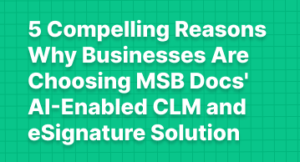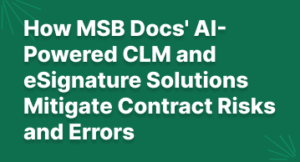Streamlining Healthcare Operations: The Power of Electronic Signatures
For years, healthcare organizations have used wet signatures to establish consent. Lately, document sign-offs via PDFs have become more popular. Yet, the process remains drawn out due to continual communication between service providers and recipients. This is inadequate for today’s swift consumer climate that needs fast and effortless eSignatures from healthcare firms. This article will explore why the most advanced eSignatures are vital for any digital change strategies and how they form part of a broader automated workflow system.
How do wet signatures put patient data at risk in the Healthcare Industry?
The healthcare sector is characterized by a complex web of compliance regulations and a diverse range of stakeholders such as physicians, nurses, patients, and insurance providers. Despite the challenges this poses, many healthcare organizations still rely on traditional, paper-based methods and wet signatures to ensure compliance with HIPAA regulations and minimize liabilities.
The problem is that healthcare workers and patients are swamped with paperwork. Paperwork takes away the time that should be spent saving and improving lives. An American Academy of Family Physicians (AAFP) survey showed that 60% of its members emphasized the importance of simplifying administrative tasks. Patients are also burdened by paperwork, as they must balance their treatment’s physical and emotional demands with bureaucracy.
When cancer patients arrive at a chemotherapy clinic, they are handed a clipboard and told to fill out forms, where they are likely to repeat the information, they provided before. Then they are required to sign a consent form. The burden is added to an already stressful situation.
The advent of telehealth has revolutionized patient care, allowing patients to obtain medical evaluations and guidance without traveling to a physical location. However, traditional paperwork requirements are no longer feasible. In other cases, wet signatures and paperwork aren’t just burdensome but also impossible.
There is no doubt that traditional paperwork and wet signatures prolong the completion of a healthcare process, whether in a clinic, hospital or virtual setting. Our experience with working with a wide variety of healthcare providers has revealed the following problems with traditional wet signatures:
-
1. Wet signatures contribute to siloes in healthcare
The need for physical documents and signatures to be sent back and forth between different healthcare providers can create delays in sharing information and impede collaboration between providers. There is a growing trend of healthcare providers digitizing aspects of the patient experience, but these technologies are not synchronized or fail to communicate with backend operations.
The use of wet signatures can make it harder for healthcare providers to maintain a comprehensive view of a patient’s health history, as patient information is often stored in different places and formats, making it difficult to access and share.
Health insurance companies, for example, can provide hospitals with easy access to patient information, but hospitals often fail to store this information correctly. As a result, hospitals have to chase patients for consent and information that may have already been provided, which prolongs the completion process.
If a patient who has already been treated in a clinic is asked to fill out forms and sign documents he has already provided in the past, the patient experience and operational efficiency have already been damaged.
-
2. Wet signatures add unnecessary costs to the healthcare
Wet signatures, also known as physical signatures, can increase costs in the healthcare industry in several ways. One way is through the added time and labor required to collect and process signatures on paper documents manually. This can slow down the flow of information and delay treatment and billing processes. Additionally, physical documents can be lost or damaged, leading to additional costs for replacement or re-creation.
Harvard Medical School, the City University of New York at Hunter College, and the University of Ottawa found that paperwork accounts for 34% of all U.S. medical expenses, including doctor visits and insurance. The average hospital maintains 45 million paper forms and documents that must all be stored securely yet searchable, which is not cheap.
Health administration costs four times more per capita in the U.S. ($2,479 per person) than in Canada ($551 per person) compared to their counterparts north of the border. The average cost of insurance overhead in the U.S. was $844 per person, while the average cost in Canada was $146. Some of this can be applied to the complexity of the U.S. healthcare system, but it’s all the more reason the U.S. needs to streamline its administrative processes.
-
3. Wet signatures jeopardize compliance & security in healthcare
Healthcare professionals are highly aware of compliance regulations, but paperwork processes undermine them. It is much easier to alter, forge, or lose paper forms, documents, and signatures, which makes them a liability when it comes to compliance with HIPAA. One document can put patient privacy at risk, whether it falls into the wrong hands, lies on a desk, or is lost in a sea of paperwork.
HIPAA enforces strict protocols for healthcare professionals regarding administrative management, physical security, and technical security. However, when healthcare professionals are faced with excessive paperwork and outdated systems for patient communication, it can become challenging to maintain compliance with all of HIPAA’s requirements.
Additionally, wet signatures can be lost or damaged, making it difficult to access important information. In contrast, digital signatures use encryption and authentication to ensure that the signature is valid and the document has not been tampered with.
-
4. Wet signatures are a barrier to patient-focused healthcare
Whenever a patient arrives at a clinic or hospital, they must fill out and sign tons of forms, adding another headache they don’t need. By definition, a patient is grappling with a health issue. As a result of messy and siloed processes, new doctors often force patients to repeat information that should already be in the system.
It is also possible for paper-based medical records to get lost, resulting in patients having to repeat tests in some cases. Prescriptions, for example, can be a significant burden to patients since their doctors have to print and sign them physically, and they have to pick them up on their own. It’s too much to ask of busy and sometimes ill patients.
Going Mobile: The Top Benefits of Implementing Mobile-First eSignatures
With mobile-first eSignature solutions, you can overcome the completion challenges associated with siloed systems and legacy channels. When eSignatures and eForms can be completed from the comfort of patients’ smartphones, two positive things happen: Firstly, the signature is routed directly to the healthcare provider’s system, where it is stored automatically in the patient’s electronic record. Secondly, patients are more inclined to sign the document since they can do so from anywhere: they need not wait until they are in front of their computer inbox (or worse, fill out one of those forms in the waiting room attached to a clipboard). Switching to eSignatures has an extremely high ROI, and many benefits can be felt immediately.
-
1. Increased productivity: Mobile-first eSignatures allow for faster and more efficient document signing, eliminating the need for printing, mailing, and scanning paper documents.
-
2. Improved security: Electronic signatures use advanced encryption methods to protect the document’s integrity and authenticity.
-
3. Increased flexibility: Mobile-first eSignatures can be used anywhere and at any time, as long as you have access to a mobile device with an internet connection.
-
4. Cost savings: By eliminating the need for paper and mailing costs, mobile-first eSignatures can save your business money in the long run.
Use cases of electronic signature in the healthcare industry:
- Patient onboarding
- Patient consent forms
- Staff onboarding
- Vendor onboarding
- Contract signing
- eConstent
- Prescription orders
- Audit and compliance processes
- HIPAA forms
- Insurance documents
- Medical billing
- Telemedicine
Healthcare providers benefit significantly from eSignatures when they are part of a completely automated digital process. Patients should be able to accomplish the various administrative elements in their experience quickly, efficiently, and securely without needing to be present for treatment. This leads to a positive patient experience, staff satisfaction, and lower costs – with no compromises on compliance standards.





